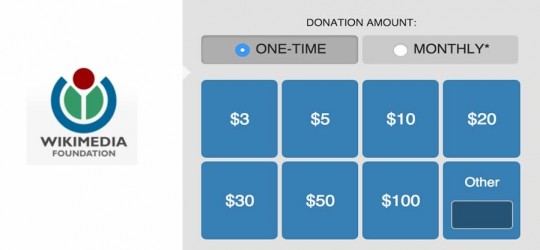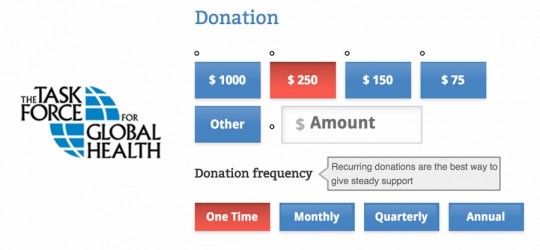The Big Mistake Most Non-Profits (and Some Businesses) Make

There’s a big mistake that many, if not most, non-profits make, and this error can reduce the number of donors and volunteers. Some businesses make the same mistake, too.
It goes without saying that most secular charities, religious groups, arts organizations, and other non-profits survive with the support of a small portion of their potential reach. We’ve all been part of groups where the same super-active volunteers carry most of the load, or where the budget depends on a small number of committed donors.
All non-profits strive to involve more people. A large, engaged community of donors and volunteers makes for a vibrant organization and better performance for the cause.
Unfortunately, an all-too-common approach to increasing donations and volunteers is to tell prospects how few people are currently supporting the group.
Donation Pitch: Low and Outside
Here’s an example. Not long ago, I heard a pastor address his congregation and give the dreaded annual “money talk.” Not once, but several times, he bemoaned the fact that 80% of the members were not contributing financially.
That is indeed a troubling and important statistic, and the pastor was right to be concerned. Even a modest change in this metric could have a major impact on the congregation’s financial picture.

The problem with highlighting the low rate of support is that it will likely backfire.
Letting congregants know that the vast majority of their fellow members don’t donate sends the signal that “most people like me don’t donate.”
That will create little incentive for non-contributors to begin donating. In fact, it could lead to current donors reducing their contributions or even stopping entirely.
Social Proof. This potential for backfire is, of course, due to social proof. People are more likely to engage in a behavior when they think other people are doing the same thing. The greater the similarity between the larger population and the individual, the more powerful the effect is.
Classic studies like the hotel towel study and energy saving study demonstrate this effect clearly.
Despite the power of social proof, in most cases the people involved are unaware of its effect. Most of us would agree that we’d choose the busy restaurant over the empty one. On the other hand, few of us would acknowledge that our energy saving behavior is influenced more by what our neighbors are doing than, say, cost savings or saving the planet.
In fact, the energy-saving study showed exactly that: subjects rated the actions of neighbors as the least important of several reasons to conserve energy. Despite the survey results, though, when actual behavior was measured by sending different groups unique letters, what the neighbors were doing was the strongest motivator.
This pastor would have been better off by focusing on a positive metric, such as the large absolute number of members who did contribute. Use of this and other persuasion techniques should be honest and ethical, so it’s important to look for the most effective truthful metric.
It might be possible for, example, to say, “76% of the members who usually attend this service contribute.” By defining a committed and active group that the individual identifies with, a positive form of social proof can be used.
A Thought Experiment. Do you doubt the power of social proof? Imagine that you were in a room with, say, 100 people, and you were asked to contribute to a cause that was good but one you weren’t highly involved with. Also imagine that you were the last person to decide, and you could see what everyone else had committed to. If zero, one, or two people from the group were the only only contributors, would you feel compelled to do so?
Now, imagine that 99 out of the 100 agreed to support the cause. Even if your contribution was secret, would you be the only one to deny them? Probably not. That’s the power of social proof. (Public contributions are also affected by social proof, but other factors come into play as well – that discussion is beyond our scope here.)
Wikipedia Fail
One of the great achievements of the Internet age is Wikipedia, the community-driven online encyclopedia. Few people would have predicted it would become the resource that it is today.
But, their fundraising approach (which actually benefits the Wikimedia Foundation) leaves something to be desired. Here’s an ad I captured the other day:
There are several ways this ad could be hurting donor conversion.
First, we see some negative social proof:

When I see “tiny percent” in this context, I immediately think less than 1%. That lets me breathe a sigh of relief, because I know that as a non-donor I’m part of the massive 99%+ who don’t donate a penny. Whew!
Anchoring. The second way the Wikipedia ad fails is by using low anchors for their donations.
The anchor effect is simply explained: the first number you see affects your subsequent behavior. Infomercials tell you that “thousands were sold at $499!” before letting you know you can have the item for just $199.
Even irrelevant random numbers have the ability to affect subsequent numeric judgments.
In this ad, Wikipedia starts by telling you that the average donation is $15. This immediately suggests to potential donors that most people give about $15 so there is no need to donate more.

Inexplicably, the low anchoring continues with the comment that if every current viewer gave $3, they would meet their goal in an hour.
This fantasy (and that’s all it is) has one main effect, in my opinion: implant the $3 number in my mind.
By using these dual anchors, Wikipedia reduces the probability that a donor will give $50 or $100, not huge sums in a prosperous population. After being primed with $15 and $3, even $25 might seem like a generous, well-above average donation.
The low number priming continues on the Wikimedia Foundation donation page I was shown:

Experienced fundraisers do the opposite. They will ask for a much larger than expected sum first. If the donor agrees with the suggestion, wonderful. But, what they are really doing is setting a high anchor so that their subsequent asks seem reasonable and the number that an individual decides to put in the donation field is higher.
Here’s an example from The Task Force for Global Health:

Note that they lead with a very large amount to set the high anchor amount. They also offer a variety of recurring donation periods, from weekly to annual. For any non-profit, having subsequent donations occur automatically is a huge win. That Wikimedia offers a monthly option is something they are doing right.
There’s a social proof effect in these numbers, too. Reading them, the prospect likely concludes:
- Almost nobody donates, since just $3 from everyone for an hour would meet the entire need.
- Those people who actually donate give $15 or so.
This is a recipe for low number of small donations.
Positive Social Proof
It’s possible, of course, that Wikipedia has tested dozens of variations and the approach I captured outperformed everything else. It wouldn’t be the first time that applying concepts proven elsewhere don’t work in a particular situation.
But, I’d love to see a more positive approach. A brief perusal of the Foundation site didn’t reveal how many donors they have, but they could plug the real number into a statement like this: “Join 247,155 donors!”
Or, why not geotarget messages? For example,
- “Join over 87,342 US donors!”
- “You can join 4,397 Austin-area supporters!”
- “23 Austin-area donors made $200 or larger contributions!”
Geotargeting would take some effort, but might pay off big-time if numbers and amounts could be matched to specific areas. Do you really want to use the exact same appeal in rural Mississippi as Greenwich, Connecticut? London? Lagos?
Obviously, the rest of the copy would have to support the message. And, as in any other case, each message be tested against a control to see if it actually does lift contributions.
Business Social Proof Mistakes
In the for-profit world, one also sees the same kind of messaging used with the intent of increasing sales. Here are some examples:
- 83% of Baby Boomers haven’t saved enough for retirement.
- 91% of PC owners don’t use a backup solution.
In an effort to create a sense of urgency about the magnitude of the problem, these marketers are letting potential customers know they are no worse than everyone else. As with the non-profits, this will backfire in most cases.
What do you think? Have you seen non-profits or businesses marketing with statistics showing that most people don’t support them? Share your thoughts in a comment.

